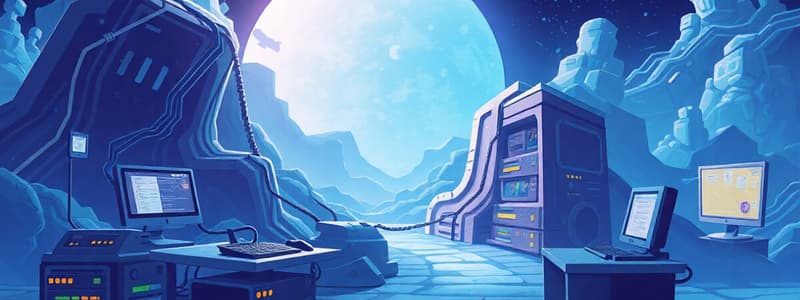Podcast
Questions and Answers
What is a key focus of software evolution processes?
What is a key focus of software evolution processes?
- Increasing the number of developers
- Eliminating old technologies
- Incorporating user feedback (correct)
- Reducing code complexity
Which aspect is NOT typically included in the study of software evolution?
Which aspect is NOT typically included in the study of software evolution?
- Initial software design (correct)
- Legacy system integration
- Version control systems
- Maintenance and updates
In which scenario is software evolution most critical?
In which scenario is software evolution most critical?
- Launching a brand-new application
- Developing a mobile app from scratch
- Updating security protocols in an existing software (correct)
- Conducting a market analysis for software products
What is one common challenge faced during the software evolution process?
What is one common challenge faced during the software evolution process?
Which of the following best describes the concept of software evolution?
Which of the following best describes the concept of software evolution?
What is a primary challenge faced by organizations regarding their software systems?
What is a primary challenge faced by organizations regarding their software systems?
What aspect of software systems may need enhancement according to organizational needs?
What aspect of software systems may need enhancement according to organizational needs?
Which of the following is NOT a typical issue related to software system management?
Which of the following is NOT a typical issue related to software system management?
Why might organizations need to focus on improving their software systems?
Why might organizations need to focus on improving their software systems?
Which factor is critical to all organizations in the context of software systems?
Which factor is critical to all organizations in the context of software systems?
What is one of the primary risks mentioned?
What is one of the primary risks mentioned?
Which factor contributes to increased risk in a project?
Which factor contributes to increased risk in a project?
Why is having a complete system specification important?
Why is having a complete system specification important?
What could be a consequence of lacking a complete system specification?
What could be a consequence of lacking a complete system specification?
Identifying risks in a project is essential. Which of the following directly contributes to this identification?
Identifying risks in a project is essential. Which of the following directly contributes to this identification?
What is the primary reason organizations invest heavily in their software systems?
What is the primary reason organizations invest heavily in their software systems?
What do most organizations allocate the majority of their software budgets towards?
What do most organizations allocate the majority of their software budgets towards?
Why must software systems be regularly updated?
Why must software systems be regularly updated?
How do organizations view their software systems in terms of business operations?
How do organizations view their software systems in terms of business operations?
What significant portion of software budgets do companies typically dedicate to existing software?
What significant portion of software budgets do companies typically dedicate to existing software?
Why do companies continue to use legacy systems despite their risks?
Why do companies continue to use legacy systems despite their risks?
What is a consequence of undocumented business rules in legacy systems?
What is a consequence of undocumented business rules in legacy systems?
What commonly hinders the upgrade of legacy systems?
What commonly hinders the upgrade of legacy systems?
What is a significant risk associated with maintaining legacy systems?
What is a significant risk associated with maintaining legacy systems?
Which statement accurately describes new software development related to legacy systems?
Which statement accurately describes new software development related to legacy systems?
What factor should determine the strategy chosen for operation maintenance?
What factor should determine the strategy chosen for operation maintenance?
Which statement best reflects the purpose of continuing normal maintenance?
Which statement best reflects the purpose of continuing normal maintenance?
What is typically NOT a consideration when determining maintenance strategy?
What is typically NOT a consideration when determining maintenance strategy?
When evaluating a system for maintenance, what should be of primary importance?
When evaluating a system for maintenance, what should be of primary importance?
What could be a potential outcome of neglecting normal maintenance?
What could be a potential outcome of neglecting normal maintenance?
Flashcards
Software Evolution
Software Evolution
The ongoing process of adapting and changing software systems over time to meet new requirements, fix defects, and improve performance.
Evolution Processes
Evolution Processes
The systematic approach to managing and controlling software evolution, ensuring quality, reliability, and maintainability.
Software System Reliability
Software System Reliability
The ability of a software system to perform its intended functions effectively and consistently.
Software System Change Management
Software System Change Management
Signup and view all the flashcards
Challenge of Software Change Management
Challenge of Software Change Management
Signup and view all the flashcards
Potential Problems in Software Change Management
Potential Problems in Software Change Management
Signup and view all the flashcards
Improving Software System Performance
Improving Software System Performance
Signup and view all the flashcards
Lack of complete system specification
Lack of complete system specification
Signup and view all the flashcards
Risk
Risk
Signup and view all the flashcards
Risk management
Risk management
Signup and view all the flashcards
Software as a Business Asset
Software as a Business Asset
Signup and view all the flashcards
Software Investment
Software Investment
Signup and view all the flashcards
Software Maintenance Cost
Software Maintenance Cost
Signup and view all the flashcards
Software System Value Preservation
Software System Value Preservation
Signup and view all the flashcards
Tight system-business integration
Tight system-business integration
Signup and view all the flashcards
Undocumented business rules
Undocumented business rules
Signup and view all the flashcards
Legacy systems are costly to replace
Legacy systems are costly to replace
Signup and view all the flashcards
New software development can be delayed with legacy systems
New software development can be delayed with legacy systems
Signup and view all the flashcards
Legacy systems are costly to change
Legacy systems are costly to change
Signup and view all the flashcards
Software Maintenance
Software Maintenance
Signup and view all the flashcards
Software Maintenance Strategy
Software Maintenance Strategy
Signup and view all the flashcards
System Quality
System Quality
Signup and view all the flashcards
Business Value
Business Value
Signup and view all the flashcards
Choosing a Maintenance Strategy
Choosing a Maintenance Strategy
Signup and view all the flashcards
Study Notes
Software Evolution
- The course will cover sections 9.1, 9.3, and 9.4 from Somerville's book.
- The lectures are for the second semester of 1445 H/1445.
- Topics covered include: evolution processes, software maintenance, and legacy systems.
- Software evolution is defined as the modification of software to reflect changing customer and market requirements.
Topics Covered
- Evolution processes will be studied.
- Software maintenance will be examined.
- Legacy systems will also be discussed.
The 4 Fundamental SW Process Activities
- Software Specification (Requirements Engineering) focuses on defining the software that is to be produced and the constraints.
- Software Design & Development involves designing and programming the software.
- Software Validation ensures the software matches customer requirements.
- Software Evolution modifies the software to reflect changes.
Software Change
- Software change is inevitable.
- New requirements emerge due to software usage and changing business environments.
- Errors need to be fixed.
- New hardware and equipment may be added to the system, requiring adaptation and improved functionality to maintain system performance and reliability.
- Implementing and managing changes to existing software systems is a key problem.
Importance of Evolution
- Organizations heavily invest in software systems, which are considered critical business assets.
- Maintaining the value of these assets requires changes and updates.
- The majority of software budgets in large companies are allocated to updating and evolving existing software instead of creating new software.
Spiral Model of Development and Evolution
- A spiral model is a development and evolution process.
- The model has iterative stages that include specification, implementation, validation, and operation.
- Iterative improvements are made based on feedback and results from the operation phase.
Evolution and Servicing
- Evolution is a stage in a software system's lifecycle, where the system is in operational use and evolving as new requirements are proposed and implemented.
- Servicing focuses on keeping the software operational through bug fixes, adapting to changes in the environment, but without adding new functionality.
- Phase-out is the stage where no further changes are made to the software, and it could still be used.
Evolution Processes
- Software evolution processes depend on:
- The type of software being maintained.
- The development processes used.
- The skills and experience of the people involved.
- Proposals for change should be linked with affected components for accurate cost and impact estimation.
The Software Evolution Process
- The process consists of stages including change requests, impact analysis, release planning, change implementation, platform adaptation, system enhancement, and system release; fault repair included.
Agile Methods and Evolution
- Agile methods are based on incremental development.
- Evolution is a seamless continuation of the development process through frequent system releases.
- Automated regression testing is valuable for changes.
- Changes can be documented as user stories.
Software Maintenance
- Modifying a program after it is in use.
- Maintenance typically doesn't involve major changes to the system architecture.
- Changes occur through modifying existing components and adding new ones.
- Three types of maintenance: fault repair, environmental adaptation, and functionality addition.
- Maintenance costs may decrease with increased effort during system development, which improves maintainability and decreases costs related to understanding, analysis, and testing.
Legacy Systems
- Legacy systems are older systems that utilize languages and technologies no longer used in new system development.
- Legacy software is often dependent on older hardware (e.g., mainframes) and associated legacy processes/procedures.
- These systems may also include other aspects, including hardware, libraries, and supporting software and business processes.
Legacy Systems - Change or Replace?
- Replacing legacy systems is risky and expensive, leading to businesses maintaining them.
- Risks include incomplete system specification, tight system/business process integration, undocumented business rules, and potential budget overruns.
- Legacy systems can be expensive to change due to inconsistent programming styles, outdated languages, inadequate documentation, degraded system structure, and program optimization difficulties. Data errors, duplication of data, or inconsistencies can also be problematic
Legacy System Management
- Organizations using legacy systems must choose a strategy for evolving them.
- Strategies include completely scrapping the system, replacing/transforming through re-engineering, replacing with COTS (Commercial Off-The-Shelf) software, or continuing with normal maintenance.
- Strategy selection depends on system quality and business value.
Studying That Suits You
Use AI to generate personalized quizzes and flashcards to suit your learning preferences.
Related Documents
Description
Explore key concepts from Somerville's book on Software Evolution. This quiz covers evolution processes, software maintenance, and legacy systems as outlined in the specified chapters. Test your understanding of software change and the fundamental activities involved in the software process.




